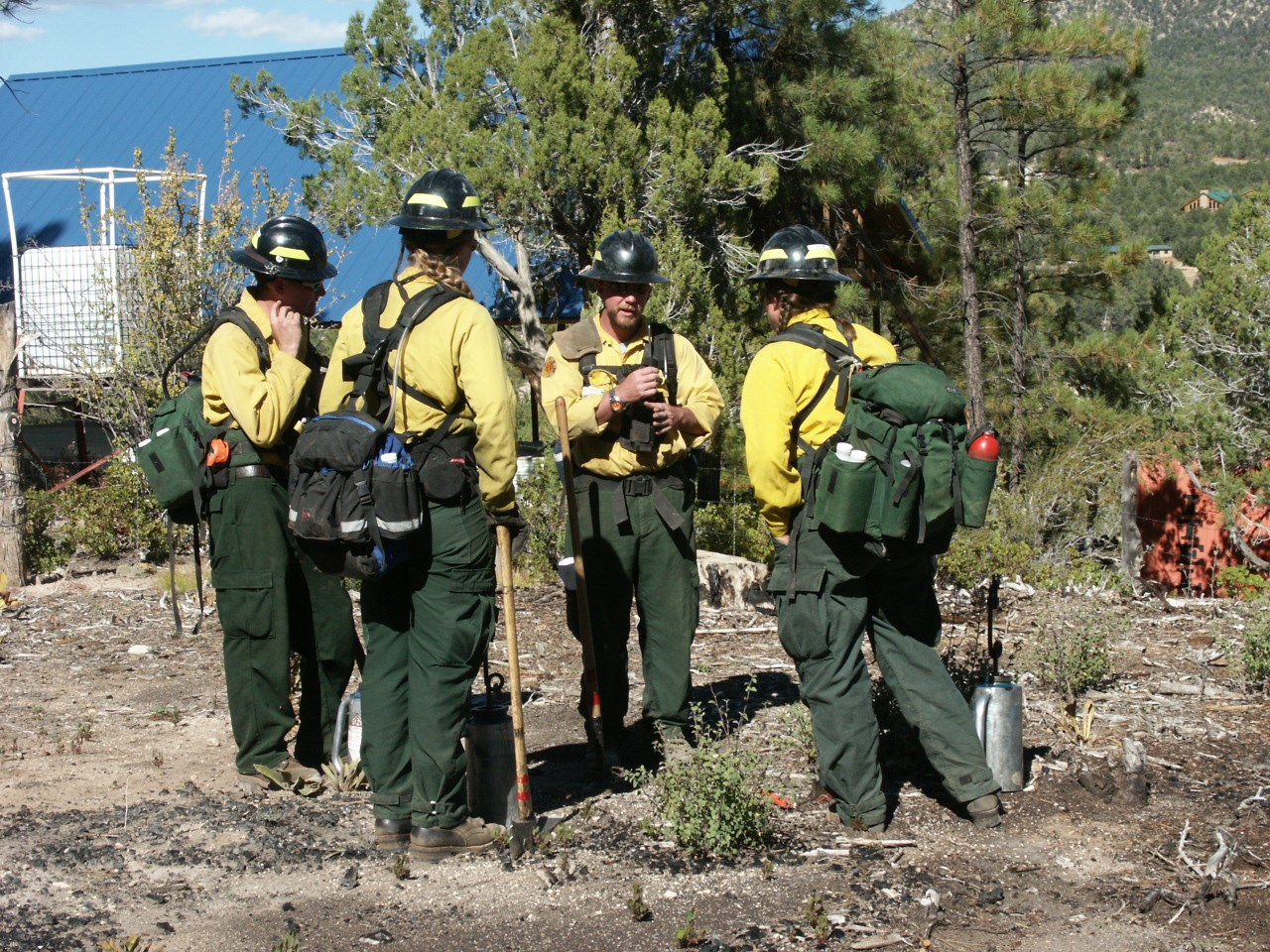
The Fire and Aviation Management Program in Zion National Park encompasses a wide variety of disciplines, all striving to apply scientifically-based research to the aspects of how wildland fire is managed in the park. The Zion Fire Management staff includes wildland engine operators, program assistants, fire effects monitors, a fire communication and education specialist, and a fire management officer and assistant who oversees the entire program. The staff includes both permanent and seasonal personnel. 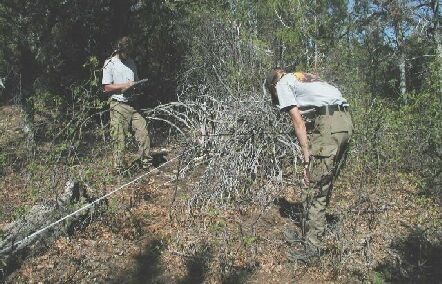
Fire Effects Monitoring CrewThe Zion Fire Effects Monitoring program was established in 1994 to help fire and resource managers better understand the role that prescribed fire has on vegetation in the park. Information about the use and effects of prescribed fire on park resources is critical for making sound, scientifically based management decisions. Fire and resource managers establish a prescribed fire burn unit within the park to meet resource objectives as stated in the Fire Management Plan. A four/five-person Fire Effects Crew (supervised by the park's Fire Ecologist) then establishes randomly selected monitoring plots within the planned burn unit. Within portions of each 20x50m plot, the crew evaluates and records numerous components of the vegetation such as; genus/species, total numbers, age class, size and condition. Many of the plants are mapped and the larger tree species tagged both for future re-location. The depth of the duff and litter layers on the ground are also measured and recorded. All of this information is then entered into a computer database for future comparisons. Within 1-2 months after the prescribed fire, the crew returns to the treated plot and reevaluates many of the same components of the vegetation. Reevaluations then occur at 1, 2, 5, 10 and 20-year intervals to determine the long-term effects of the prescribed burn on the vegetation. Analysis of the fire effects monitoring data shows long-term vegetation trends and responses to prescribed fire. This data is utilized to determine whether or not a prescribed fire achieves the desired objectives and what, if any, adjustments need to be made. 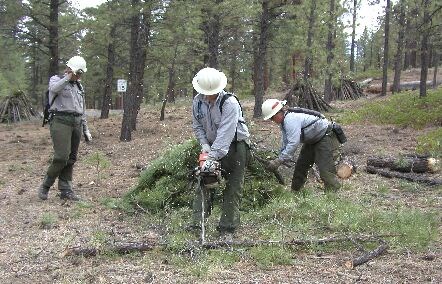
Fuels Management CrewZion's Fuels Management Program addresses the overly dense vegetation that is the result of decades of fire exclusion from public lands. The reduction of hazardous fuels accumulation is one of the key elements of the 2000 National Fire Plan. It is the understanding that reversing the effects of a century of aggressive fire suppression will be an evolutionary process, not one that can be completed in a few short years. The specific objectives of the fuels program in Zion are to reduce the total amount of fuel in an area and provide "defensible space" around homes and other structures. Fuel management activities will incorporate all types of treatments necessary to change forest conditions from higher to lower risk classes, and to maintain those areas in which a desirable condition class has been established. Activities will generally focus on wildland-urban interface areas to reduce risk to people and property. The Fuels Program is coordinated by a Fuels Management Specialist who supervises a field crew of 5-6 firefighters. The crew's main duties are to reduce the impacts of unwanted wildland fires on communities (both in and surrounding the park), natural resources, and cultural resources. This is accomplished by reducing the amount of fuels in a given area by a variety of methods including prescribed fire and mechanical and chemical methods. The crew also assists with other aspects of the fire management program in the park such as preparing, igniting and holding prescribed fire units and initial attack on wildfires. These activities are carried out both in the park and the surrounding area. The crew may also be sent to assist in fire operations throughout the country when needed. 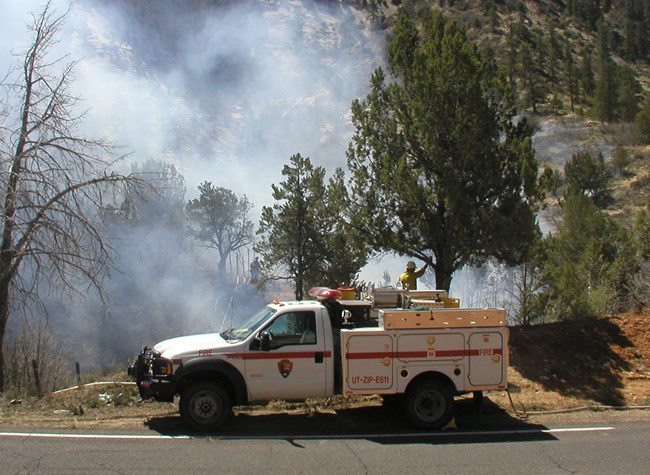
Wildland Engine CrewsZion National Park maintains one Type 6 and one Type 4 Wildland Fire Engines. Each engine is assigned a three-five person crew, consisting of an engine foreman and two firefighter crew members. All crew are capable of driving the vehicle and managing all other aspects of its operation. Their main duties are the initial attack of wildland fires throughout the park and to assist as needed on wildland fires in the surrounding area. They also assist with the management activities of prescribed fires in the park and surrounding area. These 4x4 trucks are powered by direct injection, turbo-diesel engines and are at home either on the road or off-road. The Type 6 engine engine can carry 280-gallons of water and the Type 4 can carry 750 gallons. They each carry around 2000+ feet of various size hoses plus all the associated fittings, connections and valves. They also carry firefighting tools, a portable water pump, chainsaw, fuel and safety equipment. 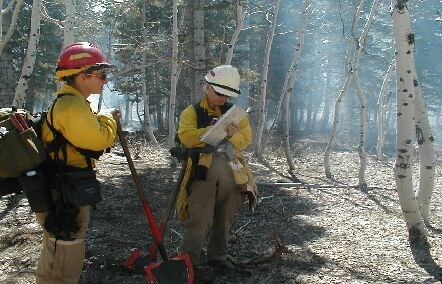
Fire MonitorsAfter a park receives report of a fire, fire monitors are sent to investigate. First, monitors determine whether the cause of the fire is human-caused or natural. Fires caused by human activity are suppressed but natural fires are allowed to burn as long as they do not threaten people, property or resource values. After determining that a fire start is natural, monitors collect information that will allow wildland fire managers to predict the fire's behavior. Monitors record the location, current weather, site vegetation , slope-aspect, fuel loading, flame length and rate of spread and take photographs. They map the perimeter of the fire and assess the fuels at the head. This information is radioed to the Wildland Fire Dispatch Office. Monitors also collect fuel samples which may include foliage, herbaceous vegetation, forest floor litter, and dead logs in various size classes. The fuel samples are weighed, dried in an oven and re-weighed. The resulting figures indicate the amount of moisture in the fuel which allows fire managers to anticipate how intensely and quickly a fire will spread. Fire monitors may stay on a small, smoldering fire for only an hour or so every few days. They may also camp out for days or weeks on larger fires with more potential to spread, continuing to collect information on fire behavior, fuels and weather. Fire monitors also collect daily weather information for stations around the park. Monitors measure temperature, precipitation, relative humidity, dew point, winds and fuel moisture. The information is used to assess fire danger and to predict the behavior of wildland fires. 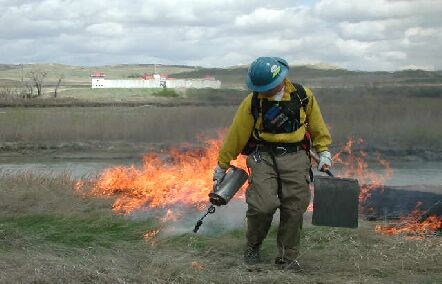
Fire Use ModuleZion's Fire Use Module provides skilled and mobile personnel for wildland fire use or prescribed fire management. They are self-contained and range in size from 4 to 10 persons. They travel carrying all equipment needed to accomplish their mission and are proficient in filling various roles on minimally scouted fire operations in remote locations. The mission of the Fire Use Module Program is to develop and provide national self-sufficient, multi-skilled fire professionals with a primary commitment to fire use operations and planning. Primary priority and purpose of the Fire Use Modules is to assist their agencies with fire use in the areas of planning, fire behavior monitoring, ignition and holding. In addition, project preparation and execution with narrow prescription windows will also be equally considered. The secondary priority is to assist other agencies in fire use and tertiary priorities are to assist the National Park Service (NPS) in prescribed fire preparation, fire effects, and mechanical hazard fuels reduction. There are eleven modules available nationally with 9 assigned to the NPS and 2 to USDA Forest Service. When the nation is in Preparedness Level 4 or 5, modules can be used to support the suppression effort. |
Last updated: November 11, 2021
